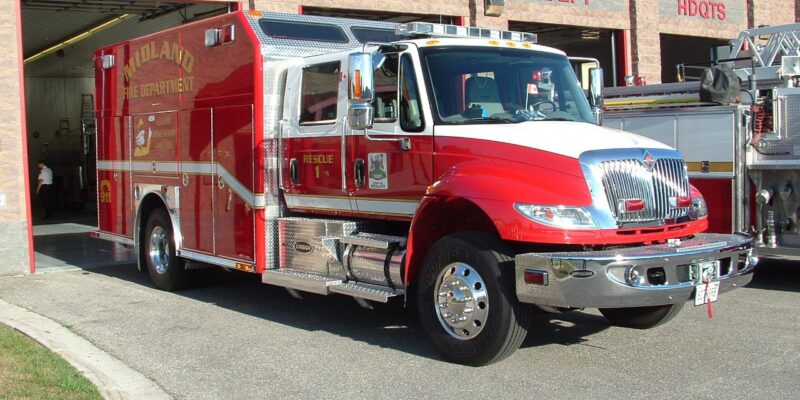


This fall, the Drivewise specialized 3D training team, with support from software partner FutureShield, were in Midland, Ontario to begin 2 days of incident command training in the virtual world with the Midland Fire Department. The XVR simulator used in Midland includes multiple environments such as a residential centre, harbour, campground, airport, train station, petrochemical facility and others. The simulator allows fire departments to design their own training scenarios within a 3D environment. 12 Midland firefighters participated in the exercises.
To begin, an overview session was provided to all the participants approximately one week in advance of the scheduled training. The overview included a demonstration of the system and explanation of the exercises that were to follow in order to provide a comfort level to the participants in this new and exciting training opportunity.
The first step in training included basic joy sticks skills. Students first learned how to move (stand, walk, kneel, crawl), look around, and use equipment such as binoculars, SCBA (self-contained breathing apparatus) and LEL and Survey Meters. Training was provided in a multi-screen environment with an instructor, facilitator, and student PC. The instructor controlled the scenario as the student moved through the 3D environment making decisions based upon the conditions they found at the site. Depending on the performance of the student, the facilitator was able to add or remove threats by responding to the decisions the student made.
In consultation with Midland Fire Department Fire Chief Kevin Foster it was decided to take students through the first 5 minutes of an emergency incident as an Incident Commander. The students were divided into groups of four so that each group would participate in one four-hour session.
A house fire scenario to further improve their incident command skills in the initial moments of an emergency was the first situation the students faced. The incident was radioed in by dispatch with details of an explosion and house fire. The student in command provided instructions as they would in the real world while the facilitator ensured that virtual responders were reacting as instructed by the incident commander.
The second scenario came in via dispatch as a call from a neighbor reporting a house fire. As the crew arrived the Incident Commander found a contents’ fire with a possible rescue situation.
The third scenario involved a large amount of black smoke coming from a duplex building. Upon arriving on site visible flames were witnessed coming from the garage. Garage contents and a gas connection made this scenario very dangerous and tested incident command skills in a very real-world scenario.
Other scenarios practiced included smoke alarm activation calls where crews found both non-active fire situations and actual fire situations while conducting their scene size-up , a controlled burn at an industrial building, and various traffic incidents.
Scenarios could have been made much more complex, but Fire Chief Foster wanted to ensure that his commanders were practicing the most likely scenarios to occur in the community in this initial training that could be built upon in the future.
Fire Training Officer, Don Hebner said “The simulator is very realistic and job related. Although it has more of a European flair, we look forward to take it to the next level by adding portable communications, Canadian specific objects, and task level strategic play. It’s a great experience and brings home the incident command system. XVR is a great tool to hone your skills on and play out scenarios. I think that a lot more departments should take advantage of it.“
It was fascinating to watch seasoned firefighters command a virtual response for the first time. The generation gap many would perceive was not evident because the real world was duplicated virtually complete with adrenalin and surprise incidents. A group critique completed each scenario so students could learn from each others’ experience which meant that monitoring the scenario offered as much benefit as being on the joystick and commanding the incident. Students often referred to requiring other first responders’ involvement such as EMS. The XVR system will facilitate multiple roles and multiagency response if in the future the Town of Midland wants to involve other responding agencies.
Instructor/Facilitator Gary Mason provided the training as a consultant to Drivewise, and is also a member of the Vaughan Fire and Rescue Service. “I like training within the virtual reality world using XVR, because it adds a new dimension of reality to scenarios. In the past we looked at pictures on the wall and then went to tabletop exercises with hot wheel cars and cardboard construction houses. XVR takes imagination and play acting out of it, and puts the responder into the real scenario in a way never possible before” he said.
For more information:
Kevin R. Foster Director of Fire Services (Fire Chief) & Emergency Management, Town of Midland: [email protected] (705) 526-4279
Lesley de Repentigny - CEO, Drivewise Safety [email protected] (705) 730-1130
FutureShield[email protected] 416-675-7835
> Training not just fun and games for firefighters" - (Dec. 6 2011) by Nicole Million Simcoe.com
Return To The Press Room